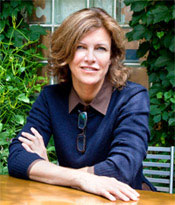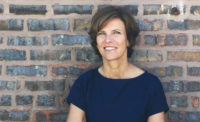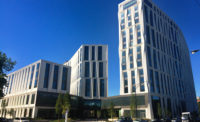 |
| Photo © Chris Kitahara |
With a portfolio of widely praised projects, including Chicago’s Aqua Tower, to her credit, architect Jeanne Gang can now add “genius” to the list of accolades she has received for her work. Last week, the 47-year-old founder of Chicago-based Studio Gang Architects was named a 2011 fellow by the John D. and Catherine T. MacArthur Foundation. She is only the fourth architect to receive the distinction commonly known as a “genius” award. Each of this year’s 22 fellows receives a no-strings-attached grant of $500,000 dispensed over five years.
We caught up with Gang to hear about her reaction to receiving the fellowship, her plans for the award money, and where she feels the architecture profession is going in the years ahead.
Asad Syrkett: So, how are you doing? How have things changed since you became a MacArthur Fellow?
Jeanne Gang: [laughs] Well, it’s just a bit crazier than usual, but besides that, nothing’s changed.
AS: Were you surprised?
JG: I was surprised; it wasn’t on my radar as something to even be watching out for. I guess they normally announce in September, but I wasn’t even thinking about it, so it really was a great, great surprise.
In this excerpt from a film by the Checkerboard Film Foundation (www.checkerboardfilms.org), Jeanne Gang, FAIA, and developer and architect James Lowenberg show us Gang's new Chicago residential high rise.
Film production team Spirit of Space (www.spiritofspace.com/) shoots Studio Gang's multi-use pavilion in Chicago's Lincoln Park. The pavilion is part of a $6 million restoration of the four-acre site, originally constructed in the 19th century and fed by city tap water.
AS: How did you get the news?
JG: A phone call! And it came at the end of a long week and a tough meeting.
AS: What are your plans for the award funds?
JG: Well, I’m going to make a specific plan, as [the award] is something you receive over five years, and I want to make sure I have a five-year plan. The general idea is that I’ll be using it for our research or prototype work, more of the experimental side of our practice.
AS: How will the award change things in your office and for your practice?
JG: Well I think it gives a boost to that [research and experimental] side of the practice. It’s always a struggle to try and find the funds to do the things that you want to do, especially for research. We’re currently working on a book about the Chicago River and we’ve had to ask for grants. And you keep getting the budget back and you’re, like, ‘okay, printing costs just went up, we have to cut five pages.’ So it’s always a balancing act. [The award] will alleviate a little bit of the stress of finding the funding for some of these things and allow us to better explore the directions that we want to go in.
AS: There have been very few architects designated as MacArthur fellows. Do you feel that your receiving the award elevates the profession?
JG: Oh, I absolutely think it does. We’ve been, as architects, kind of underrepresented in this award and I think the main thing is that people don’t understand all the things that we architects do. They might put us in the category of professionals and not thinkers or creative people who are working on really crucial issues that affect all of us. But we do! So, it’s great to bring that forward. I think architects are really key right now in terms of addressing issues of the environment and addressing places on the planet that are being hit hard by the combination of poverty and natural disaster. Not only that, but architects are really good at collaborating and we bring a lot of different fields together.
AS: Where do you see the architecture profession going in this economic climate?
JG: Well, I don’t know if you read about the Museum of Modern Art’s Foreclosed: Rehousing the American Dream exhibition that we’re a part of. It’s an interesting exhibition that starts to ask questions about how we rethink suburbia given the foreclosure crisis and the environmental issues of forcing people to drive way out to live. How do we rethink these patterns of settlement that are so crucial to the way that we will live next? The building side is important but it’s also really crucial to see the intersection of architecture, urbanism, and landscape design and to come up with solutions in those areas.
AS: Those kinds of collaborative solutions seem central to the philosophy behind your practice. Can you elaborate?
G: Well, it’s really about trying to pull expertise out of different fields and bringing that expertise together through the design process. Not starting out as if you know the answer, but starting out as if you know what the questions are and then trying to be open-minded enough to let other people’s expertise influence you. It’s one thing to have one consultant working on a problem and following the architect’s lead, but it’s quite different when you really are trying to listen to what different people are saying. Everyone works with structural engineers and landscape architects, etc. But there are two ways of working: One is to let them develop something based on your preconceived idea, and the other way is, at least in the beginning, to get really good, solid input and then try to do something that responds.


